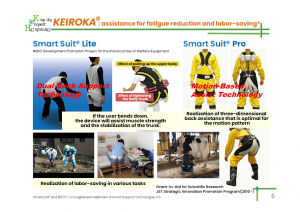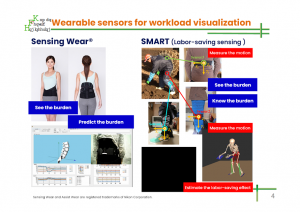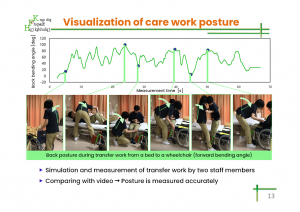- HOME
- Wow! Cool Laboratory [Researcher Introduction]
- Takayuki Tanaka
Wow! Cool Laboratory [Researcher Introduction]
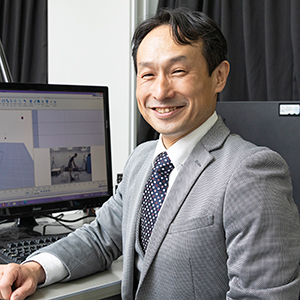
Division of Systems Science and Informatics,
Research Group of System Creation,
Human-Centric Engineering Laboratory
Field of research: mechanics, mechatronics, robotics, intelligent mechanical systems, human interfaces, interactions, measurement engineering
Research theme: power assistance, musculoskeletal models, muscle activity sensing
E-mail: ttanaka[a]ssi.ist.hokudai.ac.jp
Aiming for a “system that is ideal for people” to build an appropriate coexistence relationship between robots and humans
Supporting part of the work to maintain and reinforce physical function
In order for robot systems to coexist and cooperate with humans, sensing, control, and systematization technologies that operate in the real world are essential. The Human-Centric Engineering Laboratory, led by Professor Takayuki Tanaka, is engaged in research on wearable robots, wearable sensors, human-robot cooperation, human expansion technology based on human robotics, robot mechatronics, measurement engineering, and ergonomics.
The concept is a “system that is ideal for people.” Professor Tanaka says, “The purpose of the robot system we consider is to reduce workers’ physical strain by appropriately assisting with part of their work or their physical ability.” In fields such as agriculture, long-term care, logistics, construction, and manufacturing, there are many manual tasks and those that can only be done by humans, and it is difficult to completely robotize such tasks. Accordingly, the labor-saving Smart Suit® has been developed to reduce the risk of injury and illness caused by work and to maintain the user’s physical ability to continue working by supporting independent motions (Note 1). In October 2008, Smart Support Technologies Inc., a venture company from Hokkaido University, was established to provide Smart Suit® to various fields. The laboratory has also established an organization referred to as the Labor-saving Study Group, which is an industry-academia collaboration, to work on the research and development of labor-saving technology and its widespread use in society.
* Smart Suit® is a registered trademark of Smart Support Technologies Inc.
Visualizing workload for appropriate assistance
Wearable sensors (Note 2) for visualizing workload have been developed in parallel with Smart Suit®. Sensing Wear®, which was jointly developed with Nikon Corporation, has a function that can be called a “wearing X-ray” to measure and estimate the burden on the lower back when loading and unloading goods. Since the burden can be measured simply by wrapping it around the waist, it is effective for the labor management of workers and is attracting attention from the field of industrial hygiene. Assist Wear® can measure posture and muscle activity with sensors, predict the burden on the lower back with artificial intelligence, and automatically give more support to the pelvis according to the burden.
Professor Tanaka says, “By visualizing the workload, it is possible not only to detect the danger lurking in the work, but also to optimize the work mode in consideration of the environment in which the work is being performed and the physical functions of the workers there.”
* Sensing Wear and Assist Wear are registered trademarks of Nikon Corporation.
Development of technology to automate and support work in a long-term care setting
Professor Tanaka now focuses on the support system in a long-term care setting. “In long-term care facilities, various personal care tasks are performed for care recipients, and it is required to record when and what kind of task was done. It takes a considerable amount of time and effort to fill in the care record. We are wondering if we can automatically record care tasks by recognizing the tasks using wearable sensors,” he says.
Using sensors, the research team has measured a series of motions when the caregiver transfers the care recipient from a bed to a wheelchair and has used these measurements to make a statistical model. The motions equivalent to the model are recognized as “transfer work” (Note 3). The demonstration experiment at a long-term care facility has showed highly accurate detection of the actual transfer work, building up great expectations among long-term care facilities.
Concerning the robot wheelchair-based support system, the laboratory is also working on the construction of a system in which humans and robots cooperate, such as a robot wheelchair automatically approaching the bed according to the state and motion of the caregiver and/or recipient. Professor Tanaka says, “In a long-term care setting, securing caregivers is becoming increasingly important, and with the aging of staff, more retired people will be hired as new staff at long-term care facilities. Even novice caregivers who are middle aged and above can work immediately after short-term training, and can engage in long-term care work without placing a burden on their aging body. It will become more necessary to create such an environment in the future. We believe that the technology we are advancing can also contribute to the extension of healthy working life.”
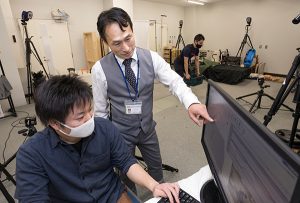 Real-time measurement and analysis of the burden on the lower back using wearable sensors. Visualization of the burden helps to detect danger, assist muscle strength, and prevent back pain. |

